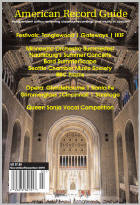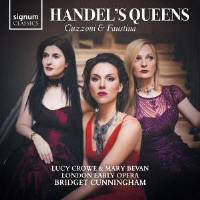Texte paru dans: / Appeared in: |
|
|
Outil de traduction ~ (Très approximatif) |
|
|
Reviewer: John
W. Barker On one level, this set is a portrait of two great divas of the first half of the 18th Century, Francesca Cuzzoni and Faustina Bordoni. There have already been, to be sure, recorded programs that celebrate them individually, but this is the first I can think of that profiles them together. The combination is given more point in demonstrating their work together, first in Venice in 1718, then in London with Handel in the 1720s, with spill-over on either side. For perspective, the programming includes music by composers other than Handel. On that count, this release might well go into the Collections section. But Handel is the defining composer.
The menu begins with Vivaldi’s Scanderbeg of 1718, when our two singers were first paired. From that we have only two arias for Cuzzoni. But the two singers also both appeared the same year in an opera by Carlo Pollarolo, and again we are given just one aria for Cuzzoni from that. Also represented by one aria, for Faustina, is Giuseppe Maria Orlandini (1721). In 1724, just before moving to London, Faustina also sang in an opera by Pietro Torri, from which we also have one aria. On the other end of things, from after the years of their working with Handel in London, we have an aria for Cuzzoni in an opera of 1739 by Leonardo Leo, and for Faustina we have arias from two operas of 1731, by Nicola Porpora and Giuseppe Maria Orlandini, as well arias from two operas (1730, 1740) by her eventual husband, Johann Adolph Hasse.
The backbone repertoire comes from operas almost entirely by Handel, premiered with one or the other, or both, of our singers. Among arias just for Cuzzoni, we sample Ottone (1723), Giulio Cesare (1724), Alessandro (1726), Scipione (1726), Ricardo Primo (1727), and Tolomeo (1728). As for Handel’s writing for Faustina, we have examples from Alessandro (1726) and Admeto Two other composers were drawn into the London orbit. One was a contemporary whose works were pillaged for his productions: yielding an aria for Cuzzoni by Leonardo Vinci. And an interesting curiosity is the inclusion, as a kind of final London chapter for Faustina, of a short Italian cantata by Maurice Greene, used as her “farewell song” in a departing performance she gave before leaving London— moving from theater to salon.
There are, by the way, two brief orchestral pieces, both with connections to vocal works. It was relatively rare in this period for a company to mount an opera production with two prima divas. The fact that several times these two singers were brought into such productions is testimony to the high esteem they were held in (and both were big box-office draws). Competitors they certainly were, and Handel counted on it. A spurious story developed at the time that the two were bitter rivals, scrapping and conniving, even coming to physical violence and hair-pulling on stage at one performance. In reality, things never got that far. Rivals they were, but they never stooped to outright violence. It was rather the troops of passionate admirers who produced tumults and fistfights in audiences. Still, a taste of their rivalry is suggested here in the duet they share in Handel’s Alessandro, where they compete lustily in their lavish embellishments. Impressions of the time suggest contrasts between the singers. Cuzzoni was compared to a nightingale and praised for tender emotions, but Faustina was prized for stronger emotional expression. Our performers here are perhaps well suited: Crowe with her bright soprano against Bevan with a darker, richer, almost mezzo-like tone. But composers sought to give the best shows and wrote display pieces full of fireworks. Our two certainly dig into the roulades, pitch leaps, and fabulous runs. And they are both generous with embellishments. Make no mistake: this is virtuosic singing. So here we can declare a draw in the competition and relish the results.
This is no ordinary collection of Baroque opera arias, one piled on another. By tracing in parallel the work of two great singers, with and beyond Handel, the program really delves into the deeper realities of their kind. (But the selections are presented in scrambled order, not chronologically.) The depth of consideration is furthered not only by inclusion of the vocal texts, with English translations, but by the very probing and illuminating booklet notes, complete with detailed comments on each item. No lover of Baroque opera should be without this set. | |
|
|
|
|
Cliquez l'un ou l'autre
bouton pour découvrir bien d'autres critiques de CD |
|




